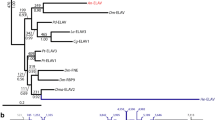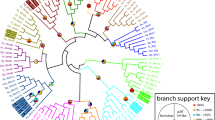Abstract
How morphological diversity arises through evolution of gene sequence is a major question in biology. In Drosophila, the genetic basis for body patterning and morphological segmentation has been studied intensively. It is clear that some of the genes in the Drosophila segmentation program are functioning similarly in certain other taxa, although many questions remain about when these gene functions arose and which taxa use these genes similarly to establish diverse body plans. Tardigrades are an outgroup to arthropods in the Ecdysozoa and, as such, can provide insight into how gene functions have evolved among the arthropods and their close relatives. We developed immunostaining methods for tardigrade embryos, and we used cross-reactive antibodies to investigate the expression of homologs of the pair-rule gene paired (Pax3/7) and the segment polarity gene engrailed in the tardigrade Hypsibius dujardini. We find that in H. dujardini embryos, Pax3/7 protein localizes not in a pair-rule pattern but in a segmentally iterated pattern, after the segments are established, in regions of the embryo where neurons later arise. Engrailed protein localizes in the posterior ectoderm of each segment before ectodermal segmentation is apparent. Together with previous results from others, our data support the conclusions that the pair-rule function of Pax3/7 is specific to the arthropods, that some of the ancient functions of Pax3/7 and Engrailed in ancestral bilaterians may have been in neurogenesis, and that Engrailed may have a function in establishing morphological boundaries between segments that is conserved at least among the Panarthropoda.







Similar content being viewed by others
References
Baylies MK, Martinez Arias A, Bate M (1995) wingless is required for the formation of a subset of muscle founder cells during Drosophila embryogenesis. Development 121:3829–3837
Bely AE, Wray GA (2001) Evolution of regeneration and fission in annelids: sights from engrailed- and orthodenticle-class gene expression. Development 128:2781–2791
Bhat KM, Schedl P (1997) Requirement for engrailed and invected genes reveals novel regulatory interactions between engrailed/invected, patched, gooseberry an wingless during Drosophila neurogenesis. Development 124:1675–1688
Budd GE (2001) Why are arthropods segmented? Evol Dev 3:332–342
Chipman AD, Arthur W, Akam M (2004) A double segment periodicity underlies segment generation in centipede development. Curr Biol 14:1250–1255
Davis GK, Patel NH (2003) Playing by pair-rules? Bioessays 25:425–429
Davis GK, Jaramillo CA, Patel NH (2001) Pax group III genes and the evolution of insect pair-rule patterning. Development 128:3445–3458
Davis GK, D’Alessio JA, Patel NH (2005) Pax3/7 genes reveal conservation and divergence in the arthropod segmentation hierarchy. Dev Biol 285:169–184
Dawes R, Dawson I, Falciani F, Tear G, Akam M (1994) Dax, a locust Hox gene related to fushi-tarazu but showing no pair-rule expression. Development 120:1561–1572
Dearden PK, Donly C, Grbic M (2002) Expression of pair-rule gene homologues in a chelicerate: early patterning of the two-spotted spider mite Tetranychus urticae. Development 129:5461–5472
DiNardo S, O’Farrell PH (1987) Establishment and refinement of segmental pattern in the Drosophila embryo: spatial control of engrailed expression by pair-rule genes. Genes Dev 1:1212–1225
DiNardo S, Kuner JM, Theis J, O’Farrell PH (1985) Development of embryonic pattern in D. melanogaster as revealed by accumulation of the nuclear engrailed protein. Cell 43:59–69
Eibye-Jacobsen J (1996) New observations on the embryology of the Tardigrada. Zool Anz 235:201–216
Eriksson BJ, Larson ET, Thornquist P, Tait NN, Budd GE (2005) Expression of engrailed in the developing brain and appendages of the onychophoran Euperipatoides kangaransis (Reid). J Exp Zool 304B:1–9
Frasch M, Hoey T, Rushlow C, Doyle H, Levine M (1987) Characterization and localization of the Even-skipped protein of Drosophila. EMBO J 6:749–759
Freeman G (2003) Regional specification during embryogenesis in Rhynchonelliform brachiopods. Dev Biol 261:268–287
Garey JR (2001) Ecdysozoa: the relationship between the cycloneuralia and panarthropoda. Zool Anz 240:321–330
Garey JR, Nelson DR, Mackey LY, Li J (1999) Tardigrade phylogeny: congruency of morphological and molecular evidence. Zool Anz 238:205–210
Gutjahr T, Patel NH, Li X, Goodman CS, Noll M (1993) Analysis of the gooseberry locus in Drosophila embryos: gooseberry determines the cuticular pattern and activates gooseberry neuro. Development 118:21–31
Haase A, Stern M, Wachtler K, Bicker G (2001) A tissue-specific marker of Ecdysozoa. Dev Genes Evol 211:428–433
Halanych KM (2004) The new view of animal phylogeny. Annu Rev Ecol Evol S 35:9–256
Hejnol A, Schnabel R (2005) The eutardigrade Thulinia stephaniae has an indeterminate development and the potential to regulate early blastomere ablations. Development 132:1349–1361
Hughes CL, Kaufman TC (2002) Exploring myriapod segmentation: the expression patterns of even-skipped, engrailed, and wingless in a centipede. Dev Biol 247:47–61
Imai K, Takada N, Satoh N, Satou Y (2000) (beta)-catenin mediates the specification of endoderm cells in ascidian embryos. Development 127:3009–3020
Ingham PW (1991) Segment polarity genes and cell patterning within the Drosophila body segment. Curr Opin Genet Dev 1:261–267
Jacobs DK, Wray CG, Wedeen CJ, Kostriken R, DeSalle R, Staton JL, Gates RD, Lindberg DR (2000) Molluscan engrailed expression, serial organization, and shell evolution. Evol Dev 2:340–347
Jan LY, Jan YN (1982) Antibodies to horseradish peroxidase as specific neuronal markers in Drosophila and in grasshopper embryos. Proc Natl Acad Sci USA 79:2700–2704
Kilchherr F, Baumgartner S, Bopp D, Frie E, Noll M (1986) Isolation of the paired gene of Drosophila and its spatial expression during early embryogenesis. Nature 321:493–499
Koblar SA, Murphy M, Barrett GL, Underhill A, Gros P, Bartlett PF (1999) Pax-3 regulates neurogenesis in neural crest-derived precursor cells. J Neurosci Res 56:518–530
Kornberg T (1981) Engrailed: a gene controlling compartment and segment formation in Drosophila. Proc Natl Acad Sci USA 78:1095–1099
Larsen CW, Hirst E, Alexandre C, Vincent JP (2003) Segment boundary formation in Drosophila embryos. Development 130:5625–5635
Lowe CJ, Wray GA (1997) Radical alterations in the roles of homeobox genes during echinoderm evolution. Nature 389:718–721
Macdonald PM, Ingham P, Struhl G (1986) Isolation, structure, and expression of even-skipped: a second pair-rule gene of Drosophila containing a homeo box. Cell 47:721–734
Manzanares M, Marco R, Garesse R (1993) Genomic organization and developmental pattern of expression of the engrailed gene from the brine shrimp Artemia. Development 118:1209–1219
Marcus E (1929) Zur Embryologie der Tardigraden. Zool Jb Anat 50:333–384
Minelli A, Fusco G (2004) Evo–devo perspectives on segmentation: model organisms, and beyond. TREE 19:424–429
Müller M, v Weizsäcker E, Campos-Ortega JA (1996) Expression domains of a zebrafish homologue of the Drosophila pair-rule gene hairy correspond to primordia of alternating somites. Development 122:2071–2078
Nielsen C (1995) Animal evolution: interrelationships of the living phyla. Oxford Univ. Press, Oxford, NY
Nüsslein-Volhard C, Wieschaus E (1980) Mutations affecting segment number and polarity in Drosophila. Nature 287:795–801
Patel NH, Martin-Blanco E, Coleman KG, Poole SJ, Ellis MC, Kornberg TB, Goodman CS (1989) Expression of Engrailed proteins in arthropods, annelids, and chordates. Cell 58:955–968
Patel NH, Ball EE, Goodman CS (1992) Changing role of even-skipped during the evolution of insect pattern formation. Nature 357:339–342
Pilato G, Guidetti R, Rebecchi L, Lisi O, Hansen JG, Bertolani R (2006) Geonemy, ecology, reproductive biology and morphology of the tardigrade Hypsibius zetlandicus (Eutardigrada: Hypsibiidae) with erection of Borealibius gen. n. Polar Biol 29:595–603
Prud’homme B, de Rosa R, Arendt D, Julien JF, Pajaziti R, Dorresteijn AW, Adoutte A, Wittbrodt J, Balavoine G (2003) Arthropod-like expression patterns of engrailed and wingless in the annelid Platynereis dumerilii suggest a role in segment formation. Curr Biol 13:1876–1881
Seaver EC (2003) Segmentation: mono- or polyphyletic? Int J Dev Biol 47:583–595
Seaver EC, Shankland M (2001) Establishment of segment polarity in the ectoderm of the leech Helobdella. Development 128:1629–1641
Seaver EC, Paulson DA, Irvine SQ, Martindale MQ (2001) The spatial and temporal expression of Ch-en, the engrailed gene in the polychaete Chaetopterus, does not support a role in body axis segmentation. Dev Biol 236:195–209
Shain DH, Stuart DK, Huang FZ, Weisblat DA (2000) Segmentation of the central nervous system in leech. Development 127:735–744
Siddiqui SS, Babu P (1980) Kynurenine hydroxylase mutants of the nematode Caenorhabditis elegans. Mol Gen Genet 179:21–24
Tautz D (2004) Segmentation. Dev Cell 7:301–312
Wedeen CJ, Weisblat DA (1991) Segmental expression of an engrailed-class gene during early development and neurogenesis in an annelid. Development 113:805–814
Wedeen CJ, Kostriken R, Leach D, Whitington P (1997) Segmentally iterated expression of an engrailed-class gene in the embryo of an Australian onychophoran. Dev Genes Evol 270:282–286
Whittaker JR (1977) Determination of alkaline phosphatase expression in endodermal cell lineages of an ascidian embryo. J Exp Zool 202:139–153
Acknowledgments
We thank Greg Wray, Nipam Patel, and members of the Goldstein lab for discussions and comments on the manuscript and Nipam Patel for generously sharing cross-reactive antibodies. This work was funded by NSF grant IBN-0235658 to BG.
Author information
Authors and Affiliations
Corresponding author
Additional information
Communicated by S. Roth
Electronic supplementary material
Below is the link to the electronic supplementary material.
Supplementary file 1
Confocal stack of Pax3/7 stained embryo at the stage when there are approximately 40 nuclei with Pax3/7 localization in the developing head region. Green is Pax3/7, and purple is DNA. Film starts from the head region (MOV 5 mb)
Supplementary file 2
Confocal stack of Pax3/7 stained embryo at the stage when there are approximately 60 nuclei with Pax3/7 localization in the developing head region. Green is Pax3/7, and purple is DNA. Film starts from the head region (MOV 86 mb)
Supplementary file 3
Confocal stack of a lateral view of an Engrailed stained embryo at the stage when Engrailed localizes to stripes of cells at the posterior of each ectodermal segment. Green is Pax3/7, and purple is DNA (MOV 30 mb)
Supplementary file 4
Individual confocal sections of the Pax3/7 stained embryo in S1. Anteriormost sections are upper left (GIF 295 kb)
Supplementary file 5
Individual confocal sections of the Pax3/7 stained embryo in S2. Anteriormost sections are upper left (GIF 529 kb)
Supplementary file 6
Individual confocal sections of the Engrailed stained embryo in S3. Left-most side of embryo sections are upper left (GIF 385 kb)
Film of complete z-stack of DAPI-stained embryo just as endomesodermal pouches are forming. A–P and D–V are labeled in the film. Yellow arrowheads point to the four pouches that are visible in the embryo at this time. The two posterior-most pouches are completely enclosed, and the two anterior-most pouches are incompletely enclosed in this embryo (MOV 756 kb)
Rights and permissions
About this article
Cite this article
Gabriel, W.N., Goldstein, B. Segmental expression of Pax3/7 and Engrailed homologs in tardigrade development. Dev Genes Evol 217, 421–433 (2007). https://doi.org/10.1007/s00427-007-0152-5
Received:
Accepted:
Published:
Issue Date:
DOI: https://doi.org/10.1007/s00427-007-0152-5




